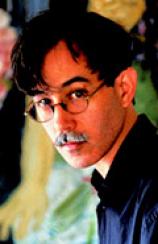The Glass Books of the Dream Eaters
Review
The Glass Books of the Dream Eaters
Gordon Dahlquist has been known primarily for his work on the
stage, writing and directing a number of critically acclaimed plays
and experimental films. His first novel, THE GLASS BOOKS OF THE
DREAM EATERS, is an ambitious project, close to 800 pages in
length, with a gradually expanding cast of characters and a plot
that is cinematic in tone and scope. It reads like an unlikely
collaboration between Jules Verne and Anais Nin, focusing on the
speculative and the erotic, yet treads boldly into and across so
many other genres that it's impossible to accurately or fully
classify the novel.
The first paragraph sets its 19th century European tone,
introducing one of the three main protagonists while incorporating
quite wonderfully a number of the elements that make the novel the
challenging, engaging work that it is. We learn within the first
few sentences that Roger Bascombe has mysteriously and abruptly
broken off his engagement to Celeste Temple by means of a short
note, which closes with the coldly polite request that Temple not
contact or see him again. Temple, being the victim of this
inelegant dumping, is understandably upset but perhaps is more
curious as to how this state of affairs has come to pass. So she
decides to surreptitiously follow Bascombe to see what --- or whom
--- has occasioned his leave-taking. In our enlightened era this
behavior would be called stalking, and perhaps it is. However, it's
not without merit --- for as Temple and the reader soon learn,
Bascombe is up to no good.
Temple watches Bascombe board a train and she boldly follows, only
to find herself in the midst of a costumed party at which some of
the masked attendants are participating in murder, mayhem and more.
The "more" in this case includes a mysterious device that is at
once deadly and powerful, one that will shape and control nations
through heads of state. Temple though is not the only interloper
present. The deadly assassin Cardinal Chang, who is neither
Catholic nor Chinese, is also secretly in attendance, dispatched on
an assignment only to discover that his intended target is already
a victim. Chang crosses paths briefly with Temple, and in turn
meets Doctor Abelard Svenson, a competent if somewhat
underachieving surgeon who also finds himself interjected into the
murky mix as he attempts to minister to his royal charge, a young
wastrel more interested in drinking and wenching than in learning
the ways and means of ruling. The lives of Temple, Chang and
Svenson subsequently intersect in common cause, separate, and
converge to traumatic and climactic effect, even as a malevolent
force beyond their understanding attempts to destroy them while
they try to save a nation.
Dahlquist paints on a broad canvas here, reveling in the
comparative freedom of prose writing while maintaining a steady
hand with admirable control and giving his imagination free reign.
As complex as THE GLASS BOOKS OF THE DREAM EATERS may be, Dahlquist
is having a good time here, and that feeling is transposed to the
reader. The work is by turns romantic, violent (very much so),
speculative, suspenseful, erotic (again, extremely so), mysterious
and thrilling, often incorporating all of these elements into a
single passage. It is also, to say the least, a challenging work:
the characters are legion, and the reader is well served to find a
way to keep track of each and every one who walks and flits across
the page, even as plotlines intersect, mate and go off in multiple
directions.
THE GLASS BOOKS OF THE DREAM EATERS is an ambitious and challenging
work that makes demands but more than amply rewards the persistent
and patient reader. And if I read the conclusion of this work
correctly, more from Dahlquist in this vein will be
forthcoming.
Reviewed by Joe Hartlaub on January 22, 2011





